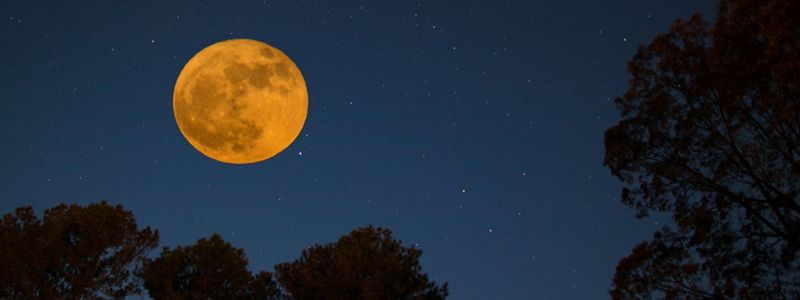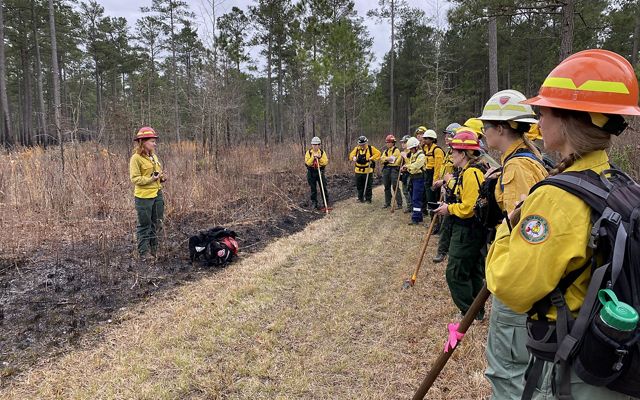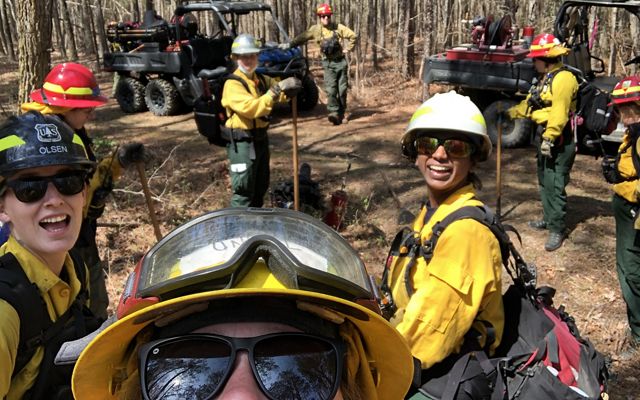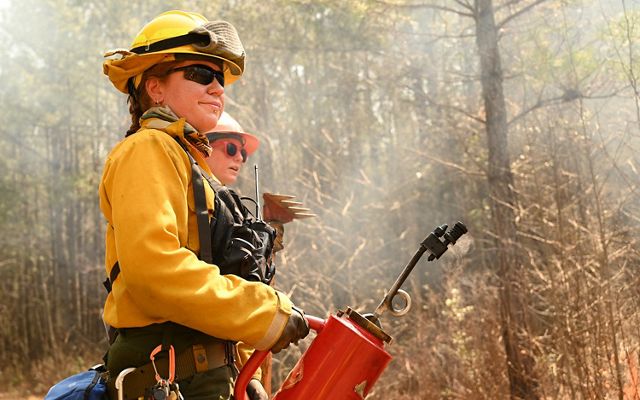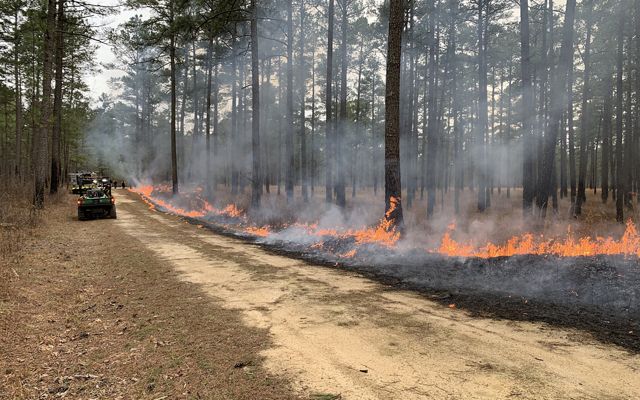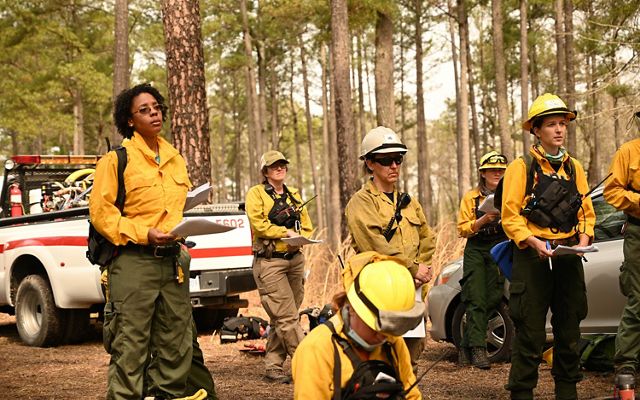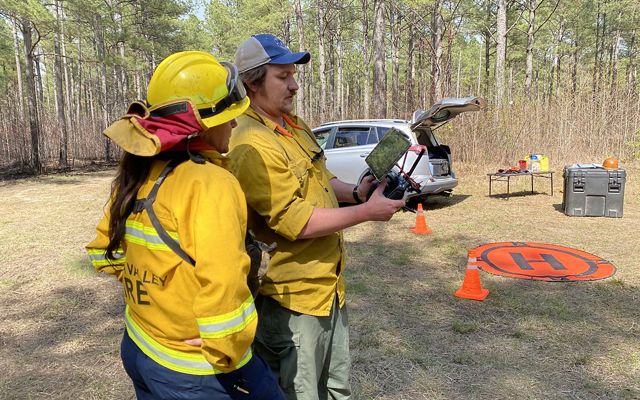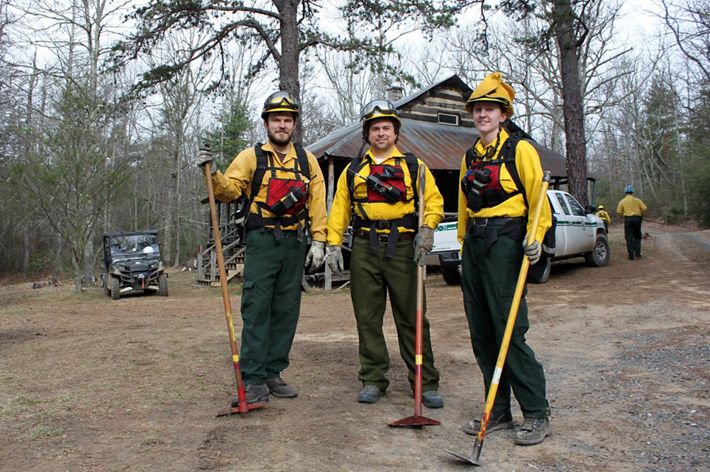Trailblazers: Women in Fire
Female fire professionals are blazing new career trails while harnessing the power of fire to restore forests.
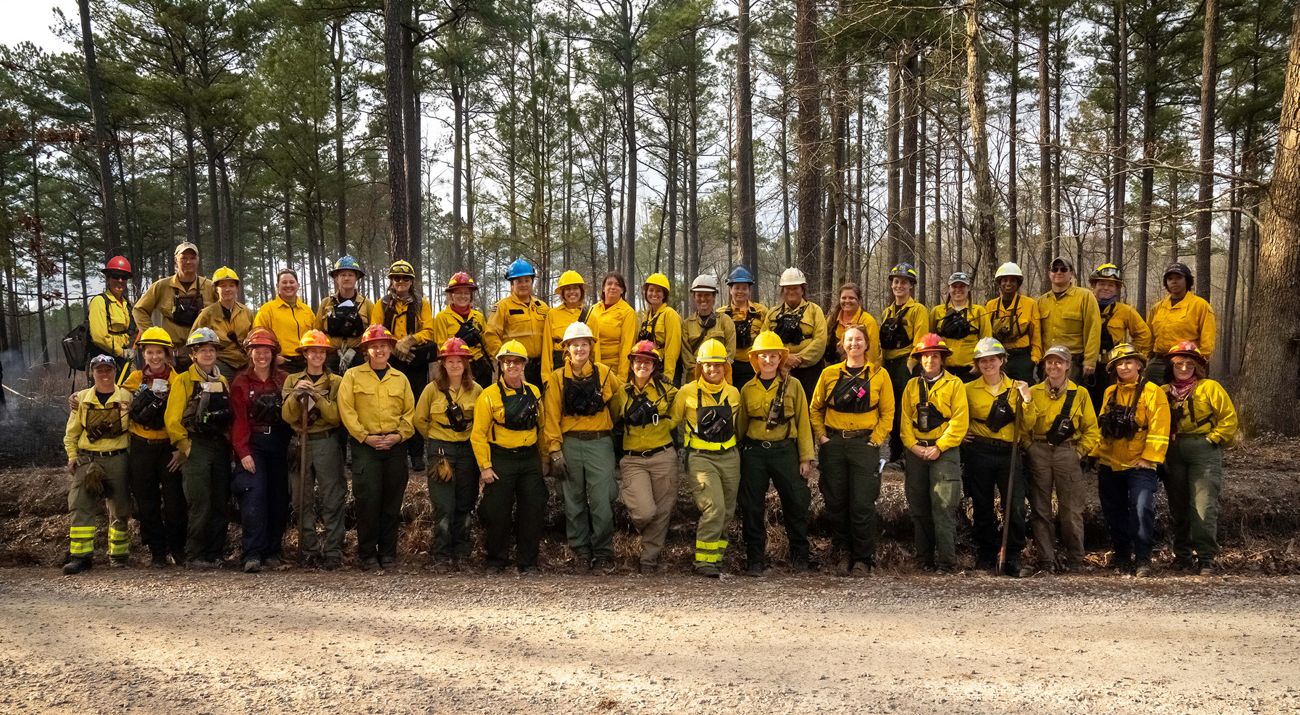
Women comprise a mere 10% of the national wildland fire workforce. A major goal of the annual Women-in-Fire Training Exchange (WTREX) is to expand career and leadership opportunities.
WTREX events bring together people of all genders from The Nature Conservancy and similar organizations, state and federal agencies, tribes and universities. Ranging from rookie firefighters to experienced burn managers, the participants engage in 10 days of hands-on training, networking and mentoring in forest landscapes across the U.S.
In 2017, Nikole Simmons and Laurel Schablein from Virginia's Allegheny Highlands Program participated in the second annual WTREX in Mariposa, California. Nikole, who has flown on aerial crews igniting some of the largest controlled burns in Virginia, served on the WTREX planning team. Following a two-year hiatus due to COVID, they joined other fire professionals from around the world for the 2022 WTREX held March 28 - April 8 at Virginia’s Piney Grove Preserve.
Nikole, Laurel and other women in fire here in Virginia—and beyond—are blazing new career trails while helping to restore vast forest systems. Read on as Senior Conservation Writer Daniel White takes you to Piney Grove to meet these forces of nature.
Burning to Learn at WTREX
Getting here was not easy.
On this cool, clear spring morning, a long-delayed gathering of wildland fire professionals is finally taking place. Some participants traveled long distances, crossing a continent or an ocean. Others have undertaken different journeys, overcoming myriad life and career challenges.
All routes have converged here at TNC’s Piney Grove Preserve in rural Sussex County, Virginia. And while Piney Grove frequently hosts fire teams conducting controlled burns, the crew assembled here today is far from typical.
A first glance might not register the difference. Everyone here wears the protective gear that comprises a wildland fire uniform: fire-resistant forest-green (or tan) pants and yellow shirts—some still neon bright, others with a patina seasoned by grime and soot—leather boots and gloves, and helmets in a variety of colors. But a closer look reveals that extending from many of those helmets is an uncommon variety of braids and ponytails.
At least 90% of the participants are women. Look at virtually any other fire crew across the country—whether they’re fighting a wildfire or conducting a planned burn—and you’ll see the reverse. In fact, many of the women here today have experienced being the only woman working with an otherwise all-male team.
They’ve come to the Virginia Pinelands for the 2022 Women-in-Fire Training Exchange, better known as WTREX.
Quote: Monique “Mo” Hein

None of us knew that we were going to show up at a TREX and there’d be six women there. We started to talk about how to make things better, not just for us but all women in fire.
Ignition and the Origins of WTREX
Spanning two weeks of intensive workshop and field experiences, WTREX 2022 aims to support and retain the women who are already working fire lines from Virginia to the West Coast, into the Canadian Rockies and at the southern tip of Africa.
Because of approaching rainy weather, today will be the third and final opportunity to conduct a controlled burn. Crew members on foot, on UTVs (utility terrain vehicles) and in water-laden engine trucks disperse from the morning briefing, cross unpaved Chinquapin Road and follow a rough fire road toward the selected burn unit.
I’m hiking at the back of the parade with Jen Fawcett, who’s serving as public information officer for WTREX, and two journalists covering today’s action for Blue Ridge Outdoors. After we reach the test-ignition site, instructors set the stage. Crew members ready water pumps or spread along the line to guard against escaping flames or embers. Virginia Department of Wildlife Resources' Andi Clinton uses a drip torch to ignite the margins of the unit and begin establishing a blackened border.
As low flames creep toward the interior forest, Monique “Mo” Hein tells me about the origins of WTREX. The idea was born in a cabin in 2015. Hein was one of six women, including TNC-Virginia’s Nikole Simmons, bunking together during a Prescribed Fire Training Exchange (or TREX) in North Carolina.
“None of us knew that we were going to show up at a TREX and there’d be six women there,” says Hein, who, when not deployed on a wildland fire, drives a 40-foot ladder truck for the Lafayette Fire Department near Boulder, Colorado. “Most of us were used to working in an environment where we were the only female on our crew.”
Thanks to a major ice storm, the cabin-bound women found themselves with a lot of unexpected down time. Along with a bottle of wine, they began sharing their stories. After a fair amount of venting, Hein says, “We started to talk about how to make things better, not just for us but all women in fire.”
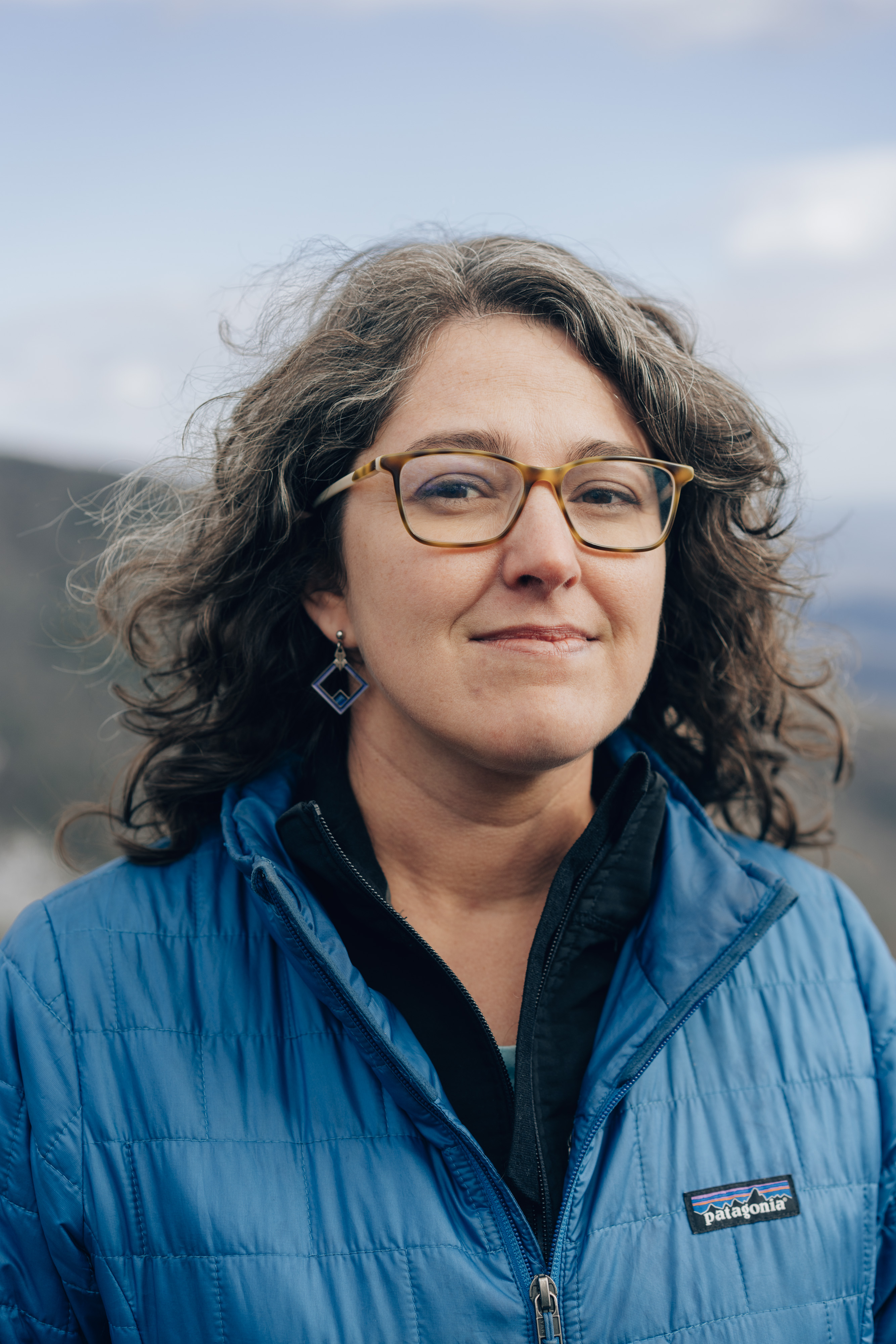
Magazine Spotlight
Virginia Trailblazer
“Some of the greatest moments of my career have been watching fire move around the landscape, mimicking the way it would have moved around historically,” says Allegheny Highlands Program Restoration Coordinator Nikole Simmons, an expert at planning and managing prescribed fires. A native Virginian with a photography degree, Simmons runs fire engines and leads burn crews. She’s handy with a drip torch and ax, can drop incendiary devices from helicopters and reads wind and weather conditions as cleansing flames crackle through forests that evolved with fire. She’s also one of relatively few women with these skills. In the United States, 84% of the federal wildland fire workforce is male.
Simmons is helping shift that imbalance. In 2015, she attended a national fire workshop called a Prescribed Fire Training Exchange (TREX for short) in North Carolina. These training sessions help fire practitioners at all career levels—from first-timers to burn bosses—learn, share and sharpen their skills. By chance, a handful of women attended the same two-week workshop.
“I hadn’t had that experience before,” Simmons says. She was accustomed to being the only woman on a crew. During downtime, the group would chat, discussing the difficulties of being a woman working in fire—everything from not being taken seriously to the ill-fitting gear designed for men. Those talks sparked a revelation: There were other women out there facing the same challenges. What if, Simmons and the others mused, there was an event to bring women working in fire together, to have a similar shared experience?
She and one of the other women from the workshop, Monique “Mo” Hein, a firefighter in Colorado, organized a call with TREX leaders. Lenya Quinn-Davidson, now head of the program born of that call, volunteered to repurpose a TREX event she was already planning for 2016 in northern California to bring together 45 people, most of them women. “There was pure shock when everyone arrived,” says Quinn-Davidson of that first Women in Fire TREX. “People said, ‘I have never been in a room with this many other women who work in fire.’ We had powerful conversations and shared emotional moments. We knew we had to do more.”
Since then, there has been one WTREX event in a different location most years (in 2020, it was virtual). The two-week events are designed to support women but open to anyone, giving practical training on prescribed fire that equips attendees with the experience they need to move up in the workforce.. The intangible benefits are equally valuable. “There’s so much laughter,” Simmons says. “It blows me away to watch how quickly these women build trust and form a team.” They leave with a support system, both professional and personal. They leave having seen and met women in leadership positions in the field.
And WTREX is just getting started. Simmons helped host one at TNC’s Piney Grove Preserve in Virginia in 2022, there will be four events in TNC’s 2023 fiscal year.
The overarching goal of WTREX is to keep women working in fire. “We don’t want people working a season or two and then feeling pushed out,” Quinn-Davidson says. “We want them to stay in the field, bringing additional perspectives to improve the system, change the paradigm, continue to evolve the way that fire is managed.” Just like Simmons is doing. — LINDSEY LILES for Nature Conservancy magazine.
One of the best-known physical requirements for fire-work certification is the infamous pack test: completing a 3-mile hike in less than 45 minutes with a loaded pack. But a 45-pound backpack feels light compared to the weight many of these women describe carrying daily in the male-dominated fire profession. They feel pressure not merely to succeed, but to avoid any mistakes that might reflect onto their entire gender.
Obviously, perfection as a standard is neither reasonable nor sustainable. Hein says it becomes an obstacle to gaining the skills and self-confidence that the job demands. The insight that the North Carolina cabin crew arrived at was to use the proven TREX model but to flip the gender dynamic. “We needed an environment that we felt safe in to learn,” Hein says.
A Global Family Forged in Fire
Park speaks from long experience, not only as a woman but also as a Korean-Canadian child of immigrants who’s risen through the ranks to lead the fire program at Banff National Park. Her entry into WTREX came just last year, as a presenter for the first online WTREX. That virtual workshop was the organizers’ attempt to reboot and regain momentum after the pandemic cancelled what would have been the 4th annual WTREX.
This year, Park traveled from Canada to join the leadership team in person, and she hopes to translate her Virginia WTREX experience into improved conditions for everyone working in fire. “One of the best takeaways is a whole network of people all across the world that we can now lean on for mentorship or learning,” she says.
Park herself has stepped up to that mentor role for a number of women here, including Kylie Paul, whose path crosses ours as we navigate around a pond-sized mudhole on our way to Beaver Dam Road. No one has traveled farther to be here than Paul, who hails from Cape Town, South Africa.
Quote: Jane Park
One of the best takeaways is a whole network of people all across the world that we can now lean on for mentorship or learning.

Paul formed Crew Juliet, which she describes as Africa’s first all-women team of volunteer wildland firefighters. But it wasn’t until bucking up against the professional realm that she realized she was different. “Suddenly I became aware that I was a female firefighter and that there were very few of us,” she says.
When Paul learned about WTREX, she was determined to reach out, even though she considered herself a long shot for the limited spaces. “I didn’t think anyone would be interested in someone sitting at the tip of Africa,” she says.
Being accepted brought new challenges, but Paul was determined to get to Virginia. “I quit my job, I packed up my house, and a bunch of folks got behind me and helped me to raise money to be here,” Paul says, with obvious gratitude. “TNC’s been amazing, helping me with travel costs and accommodations.”
For Paul, the rewards of WTREX seem to greatly outweigh the sacrifices she has made in pursuing a call to fire service that she has felt since her very first day as a volunteer. In addition to finding mentors like Jane Park and co-organizer Nikole Simmons, she now feels welcomed into “an international family in fire of women sharing that journey.” (The next phase of Paul’s fire journey would take her to Warm Springs Mountain with Simmons and her Allegheny Highlands teammates.)
Quote: Kylie Paul

Suddenly I became aware that I was a female firefighter and that there were very few of us. I've been welcomed into an international family in fire of women sharing that journey.
Quote: Zoe McGee
WTREX is physically, mentally and emotionally exhausting, but it was totally worth it. It was such a powerful experience, and we've built a community and network that we will have for years to come.

Virginia's Fire Women
For now, it’s fitting that WTREX—and conversations about expanding the program—are taking place here in Virginia. Judy Dunscomb, one of TNC’s first female burn bosses and now a senior scientist, started the fire program here more than two decades ago. So it’s not by accident that Virginia’s robust fire programs employ more women than one often sees elsewhere.
Virginia's female fire professionals share their stories in their own words below.
JUDY DUNSCOMB, SENIOR Conservation SCIENTIST
My first burn was on a longleaf pine savanna in North Carolina in 1992 when I was an intern. Years later in Virginia, we recognized that, before we could fully restore red-cockaded woodpeckers to our Piney Grove Preserve, first we would have to bring back fire.
I eventually became the Virginia chapter's first fire manager, and along the way, my two most important mentors had been women. One was a brilliant TNC scientist determined to master fire management because our forests so urgently needed it. The other had worked on U.S. Forest Service fire crews out west—one of the first women to do so, I believe.
These days, my experience with fire helps me make new connections. People tend to perk up when you say you have wildland fire leadership experience. It commands respect.
Fire work also teaches you how important it is to plan, but how unlikely burn day will go exactly according to plan. You must remain flexible, keep sight of the big picture, and stay alert for red flags that may require a change of tactics or a shutdown.
I find many parallels in my current role and in other professions. For example, during a recent discussion I was facilitating among pipeline engineers about improving construction practices, I could accept that no plan can perfectly anticipate what they will encounter during construction. And then I was also able to articulate in a fair way how important it is to share their lessons learned. Without my fire experience, I would not have been able to bring that perspective to the table.
LAUREL SCHABLEIN, CONSERVATION PROJECT MANAGER, ALLEGHENY HIGHLANDS PROGRAM
Before WTREX, I loved my occasional day on the fire lines, but I had decided that the life of a full-fledged burn crew member was not for me. I was brimming with reservations about going to WTREX. Two weeks of physically and mentally exhausting days with a big group of new people sounded terrifying—but also like a great opportunity for heaps of professional and personal growth.
It turned out to be more than I could have ever expected. With a focus on training, operations can be slowed to allow for more questions, more thorough answers, and hands-on practice that you can't always get on a typical fast-paced controlled burn.
I gathered a whole new suite of tips for wielding a 14-pound chainsaw that left me feeling 100% more confident. More importantly, I had never been part of a community of colleagues so full of strength, intelligence, compassion and empathy. It became perfectly clear to me why people crave the life of fire camp.
We worked together, ate together, bunked together and supported one another. And now, back home at my regular duties, I feel the lasting effects of the mentorship and the inspiration that WTREX cultivated. I am obliged to those who made it possible and to every participant who enriched my experience.
JENNIFER DALKE, VOLUNTEER PROGRAM MANAGER
My first experience with controlled burning was with the Georgia chapter in 2007. Most of those fires took place among amazing old-growth longleaf pines at places like Moody Forest and Broxton Rocks preserves.
One of my favorite memories was watching a gopher tortoise run (if you can call it running) into its burrow to wait out a burn. We went back to that burrow while mopping up after the burn, and out came an Eastern indigo snake—the first and only one I've ever seen. Gopher tortoise burrows provide refuge for hundreds of other species.
I was lucky enough to continue my fire work in Virginia with the stewardship team. Once you catch the fire bug, it's hard to stop. Though I took a four-year hiatus to raise my family, I returned to the fire lines in 2017 at South River/Cowbane Prairie Natural Area preserves, working alongside partners like the Virginia Department of Conservation and Recreation (DCR).
As volunteer program manager, I also recruit and place trained volunteers on TNC and partner fire teams. We have 10+ qualified volunteers who get our alerts about upcoming burns across the state. Volunteers also help us prep fire lines and monitor fire effects beyond burn season. I love being a bridge between nature and people who want to get more involved in conservation.
SAMANTHA DILLON, DAVID A. TICE SCIENCE INTERN, VIRGINIA PINELANDS PROGRAM
My first experiences with controlled burning were during my first internship in Central Florida, where I assisted with a study on how fire management affected gopher tortoise movement. I first participated in burning during my 2018 AmeriCorps term with Virginia State Parks. It was pretty neat to come full circle from studying effects to working on an actual burn!
I learn so much from every person I meet and work with on a burn, but there is definitely a sisterhood among the women in fire. We are all cut from the same cloth and passionate about habitat restoration and land stewardship. Working with women in fire has been very empowering.
Ultimately, I aim to pursue a graduate degree doing research on how fire management affects reptile and amphibian communities. After that, I would love to continue working in the field and, of course, participating in burns.
ADRIANNA "ANDI" CLINTON, Virginia Department of Wildlife Resources
During my senior year in biology at the University of Florida, I volunteered for a city park ranger named Don Musen, who took me under his wing. I started training with chainsaws and helping with pre-burn preparations such as clearing fire lines, protecting gopher tortoise burrows and attending safety briefings.
The following year, I took the local Fire Training Agency course. Since 2012, I have volunteered on more than 10 burns all across Virginia, working with DCR, Department of Forestry and TNC. After completing beginning wildland firefighter courses I continued my training to become a squad boss.
At a whopping 5 feet 4 inches, I am used to being the small one around most people, and I've pushed my physical limits far more than I ever imagined. Every year, I have to pass an arduous physical test of walking three miles in 45 minutes carrying 45 pounds. Every fire pushes my endurance further, and I accomplish more than I ever thought I could.
Fire has shown me that I can make a positive physical impact on the world. A week after a fire, you can see all of the beautiful native plants and wildlife springing back, just as they have adapted to do historically. Very rarely do you get to come back to a job years later, point to new wildlife habitat, and say, "I did that."
The Nature Conservancy invited REI to the October 2017 WTREX to film the training and introduce viewers to more of these forces of nature.
We Can’t Save Nature Without You
Sign up to receive monthly conservation news and updates from Virginia. Get a preview of Virginia's Nature News email
